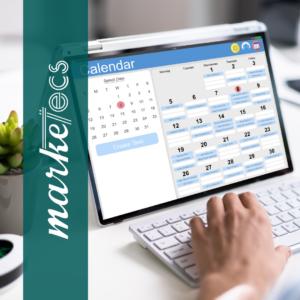Keep reading for insights into building a powerful marketing content calendar:
- Identify your content marketing goals
- Know thy audience deeply
- Plan content types & themes
- Set a reasonable schedule
- Stay organized with the right tools
- Measure & analyze!
- Streamline your marketing efforts
Yes, content is still king! Yet even the most valuable content can fall flat without a solid plan.
If you’re looking to elevate your marketing game, creating a content calendar is not just a good idea – it’s a necessity.
A well-thought-out content calendar helps you organize, plan, and execute your content marketing strategy effectively. It ensures that you’re always ahead of the game, delivering the right content to the right audience at the right time.
Here’s a practical guide to building a content calendar that drives results:
1. Define Your Content and Marketing Goals
Before diving into the logistics of your content calendar, start by clearly defining your content marketing goals. Without clear goals, your content can easily become unfocused or irrelevant.
80% of marketers have used content marketing to successfully educate their audience, while 72% have generated leads (Oberlo).
Ask yourself:
- Are you looking to increase brand awareness? If so, prioritize educational and engaging content that introduces your brand.
- Do you want to generate more leads? Focus on content like webinars, case studies, and eBooks that provide value and gather contact information.
- Is boosting engagement your goal? Develop a mix of interactive content, such as polls, social media challenges, and comment-based discussions.
For example, if lead generation is your main objective, you might aim to publish two blog posts a week, each paired with a lead magnet like a downloadable checklist. On social media, this content could be supported by teaser posts to direct followers to these resources, all while encouraging them to join your email list.
Companies that actively invest in content marketing often see these metrics drive tangible results, with many allocating up to 50% of their marketing budgets toward content creation (Oberlo)(Semrush).
2. Understand Your Audience
It’s not enough to create just any content: you need material that resonates. To do this, it’s essential that you understand your audience deeply. This goes beyond basic demographics – you want to tap into their pain points, interests, and preferred communication channels.
65% of marketers prioritize their audience’s informational needs over sales-focused messages, highlighting the importance of creating content that solves real problems (Ahrefs)(Rock Content).
To get started, ask yourself:
- Who are my clients or prospects? What problems do they face?
- What type of content are they most interested in? Is it blog posts, webinars, or maybe podcasts?
- Where do they spend their time online? LinkedIn? Instagram? Email newsletters?
For example, if you’re a coach working with mid-career professionals, they may value content that focuses on career growth, leadership development, and personal branding tips. If you understand that they spend most of their time on LinkedIn, prioritize posting long-form articles, inspirational stories, and client success testimonials on this platform.
3. Plan Content Types and Themes
Once you know your goals and audience, it’s time to decide what types of content you’ll produce – and the themes you’ll focus on each month or quarter. The most effective strategies often include a mix of formats.
89% of marketers produce blog posts, while 75% use videos to diversify their content (Semrush).
Here are some content types to consider:
- Blog Posts: In-depth articles on industry trends, how-tos, or thought leadership
- Social Media Posts: Quick tips, inspirational quotes, polls, or behind-the-scenes content
- Videos: Client testimonials, quick lessons, or behind-the-scenes footage
- Ebooks/Whitepapers: Downloadable resources that offer deep insights
- Webinars/Workshops: Interactive sessions to share expertise
- Email Newsletters: Regular updates, tips, and offers to stay top-of-mind
Next, organize these content types around monthly themes or topics. For instance:
- January: Goal Setting & Planning
- February: Leadership Development
- March: Building a Personal Brand
A consistent, thematic approach helps keep your content organized and ensures your messaging aligns with your business’s broader objectives.
4. Set a Realistic Marketing Schedule 
Now that you have your content types and themes, it’s time to create a schedule. Your content calendar should outline how often you’ll publish content and on which platforms.
While 33% of successful marketers allocate more than half of their marketing budgets to content, it’s crucial to ensure that your schedule is manageable (Oberlo).
A realistic schedule is key to consistency – trying to post too frequently can lead to burnout or lower-quality content.
For instance, your schedule could look like this:
- Blog posts: Publish one long-form post every Monday
- Social media: Share a motivational quote or tip every Tuesday and Thursday, with more in-depth content (like client stories) on Fridays
- Email newsletter: Send a monthly newsletter on the first Wednesday of each month
- Video content: Release a new client testimonial every two weeks
By mapping out your content flow like this, you can ensure you’re consistently delivering valuable information without overwhelming yourself or your team.
5. Use Tools to Keep Your Content Organized
Feeling stressed at the idea of managing a content calendar? Don’t be! It doesn’t have to be complex or time-consuming. There are plenty of tools that can help you streamline the process and keep your team on the same page.
Here are some popular options:
- Trello: A flexible, visual tool to organize content ideas, track progress, and assign tasks.
- Asana: Perfect for larger teams with multiple moving parts, helping track deadlines and responsibilities.
- Google Sheets: Great for those who prefer simplicity—create a straightforward calendar layout with content themes, types, and deadlines.
- Hootsuite or Buffer: These tools allow you to schedule social media posts in advance, freeing up time for other tasks.
For example, you could use Trello to outline your entire month’s content, attach blog drafts for review, and set deadlines for each task. Meanwhile, Hootsuite can ensure your social media posts are pre-scheduled and going live even when you’re focused on other priorities.
At Marketecs, we use our online project management system to create reoccurring tasks for each piece of content creation, allowing us to easily and efficiently see what’s done and what is still outstanding. Then we pair this task list approach with a google sheet style calendar for a monthly visual of all of content placement. And finally, we utilize scheduling tools to batch our work and ensure we’re always ‘ahead of the game’.
48% of marketers report that learning new technology is one of their top skills, making it easier than ever to use tools that simplify the process (Semrush).
6. Measure and Optimize
Your content calendar is not a static document. As you start executing your plan, it’s essential to monitor the results and optimize your approach to evolve based on performance.
Monitoring Key Performance Indicators (KPIs) like website traffic, conversion rates, and social media engagement helps you understand what’s working (Rock Content)(Semrush).
- What metrics will you track? For blog posts, monitor page views, time on page, and conversion rates. For social media, track likes, shares, and comments.
- How will you adjust? If certain content types or platforms aren’t performing as expected, you might reduce focus on those and try something new.
Regularly review your content’s performance and adjust your strategy as needed. For instance, if you notice that your leadership-focused blog posts are driving more traffic than personal branding topics, you can shift your focus to create more leadership-related content.
Some key KPIs include:
- Website traffic: Page views, time on site, and bounce rate
- Social media: Engagement rates, likes, shares, and click-through rates
- Email: Open rates, click-through rates, and unsubscribe rates
To summarize…
Creating a content calendar is more than just filling in dates – it’s about building a strategic foundation that guides your marketing efforts toward success. By defining your goals, knowing your audience, and following a structured plan, you can create a content calendar that helps drive real results for your business.
Ready to create a plan that works for your business? Contact Marketecs today to see how we can help streamline (and even automate) your marketing efforts.


